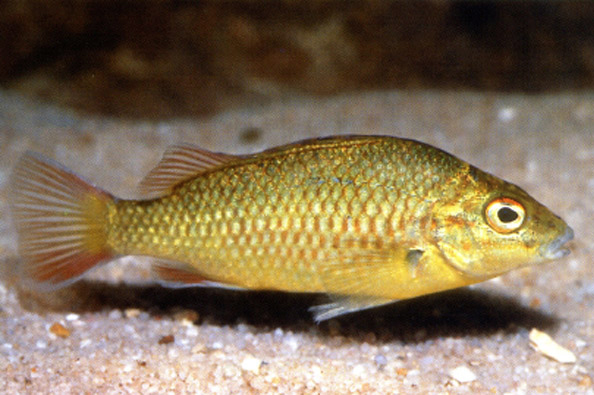Kimberley Spangled Perch, Leiopotherapon macrolepis Vari 1978

Kimberley Spangled Perch, Leiopotherapon macrolepis. Source: Gerald R. Allen. License: All rights reserved
Kimberley Spangled Perch, Leiopotherapon macrolepis Vari 1978
More Info
|
Distribution |
Prince Regent River and the Upper Roe River, systems of The Kimberley region, Western Australia. Inhabits clear flowing freshwater streams with sandstone bottoms and open rocky pools with little aquatic vegetation. |
|
Features |
Dorsal fin XI-XII, 9-10; Anal fin III, 6-9; Pectoral fin 12-15; Pelvic fin I, 5; Lateral line scales 29-33; Transverse scales 3-5 /1/8-11; Gill rakers 6-8+1+10-13; Vertebrae 10+15. Body moderately deep, 2.5-3-0 in SL, ovate, strongly compressed; dorsal profile more pronounced than lower, straight in juveniles; developing a slight concavity before orbit with age, interorbital region nearly flat, profile between rear of head and dorsal origin getting increasingly convex with age; ventral profile gently curved to anus. Head length 2.5-3.1 in SL (32.3-40% SL); snout length 2.8-3.6 in HL (27.7-35.7% HL), getting relatively larger with increasing standard length. Nostrils well separated; distance between them equal to half the diameter of orbit; posterior nostril set in a depression; neither nostril with cutaneous flap. Eye width 3.2-4.5 in HL (22.2-31.25% HL), getting relatively smaller with increasing age. Jaws equal, length 2.6-4.0 in HL; gape oblique; maxillary reaching to vertical through posterior nostril in young, to vertical through anterior edge of eye in adults; each jaw with band of fixed, conic, brown-tipped teeth; outer row largest; no teeth on vomer or palatines. Lacrimal weakly serrate in some individuals. Preoperculum weakly serrate at angle. Lower opercular spine longer and stronger; not extending beyond edge of opercular lobe. Cleithrum exposed; serrate along posterior edge; some scales on side. Supracleithrum and posttemporal covered with skin and scales. Scales large, finely ctenoid; lateral line continuous, smoothly curved; 12-14 predorsal scales to occiput; cheek scales in 4-5 rows, irregular, covered with a heavy layer of skin; sheath at base of spinous dorsal consisting of one row of scales, sheath extending to third or fourth dorsal ray; sheath at base of anal consisting of 1-2 rows of scales; sheath extending to fourth anal ray. Dorsal fin continuous, base 2.0-2.3 in SL; spinous portion arched; first spine short; fourth or fifth spine longest, 2.4-3.1 in HL, those following decreasing in length gradually to penultimate which is shorter than last; longest dorsal ray 1.92.7 in HL; soft dorsal rounded. Second anal spine strongest, length 2.2-3.4 in HL; longer than third in juveniles, subequal in adults; longest anal spine always shorter than longest anal rays; longest anal ray 1.8-2.5 in HL; soft anal square. Pectoral fins asymmetrically pointed; fourth to sixth ray longest. Ventral fins inserted ahead of vertical drawn through origin of spinous dorsal; pointed; first ray longest; slightly filamentous, falling short of anus. Caudal fin slightly emarginate. |
|
Size |
To 15 cm SL, commonly 9-10 cm. |
|
Colour |
Body darker dorsally; overall coloration much darker in adults than in juveniles, with body dorsal to level of base of pectoral fins quite dark and lacking any distinct patterning. Head dark dorsally on snout, interorbital and nape regions, continuing ventrally onto opercle, and also on premaxillary, maxillary, and dorsolateral surface of lower jaw in adults. Juveniles with a darker edging to scales. Dorsal fin dusky, more so in adults. Anal fin dusky. Pectoral fins dusky, with dark pigmentation at base, more pronounced medially and more prominent in larger fish. Pelvic fins clear in juveniles, dusky in adults. Caudal fin dusky, especially basally. |
|
Feeding |
Omnivore - feeds mainly on small crustaceans, small fishes, insects and vegetation. |
|
Biology |
Spawning occurs year round, and females are likely to deposit demersal eggs on the rocky bottom. |
|
Conservation |
Western Australia: listed as Near Threatened |
|
Etymology |
The specific name macrolepis is from the Greek macro (= large) and lepis (= scale), in reference to the relatively large size of the scales in this species. |
|
Species Citation |
Leiopotherapon macrolepis Vari, 1978, Bull. Amer. Mus. Nat. Hist. 159(5): 235. Type locality: Youwanjela Creek, tributary of Prince Regent River, Western Australia. |
|
Author |
Gomon, M.F. & Bray, D.J. 2021 |
|
Resources |
Kimberley Spangled Perch, Leiopotherapon macrolepis Vari 1978
References
Allen, G.R. 1982. Inland Fishes of Western Australia. Perth : Western Australian Museum 86 pp. 6 figs 20 pls.
Allen, G.R. 1989. Freshwater fishes of Australia. T.F.H. Publications, Neptune City, New Jersey.
Allen, G.R., Midgley, S.H. & Allen, M. 2002. Field guide to the freshwater fishes of Australia. Perth : Western Australian Museum 394 pp.
Jenkins, A., Kullander, F.F. & Tan, H.H. 2009. Leiopotherapon macrolepis. In: IUCN 2013. IUCN Red List of Threatened Species. Version 2013.2.
Lake, J.S. 1978. Australian Freshwater Fishes. Melbourne : Thomas Nelson 160 pp. 140 figs (p. 52 as an undescribed species).
Merrick, J.R. & Schmida, G.E. 1984. Australian freshwater fishes: biology and management. Griffin Press Ltd, South Australia.
Moore, G. 2019. Leiopotherapon macrolepis. The IUCN Red List of Threatened Species 2019: e.T11454A129056296. https://dx.doi.org/10.2305/IUCN.UK.2019-3.RLTS.T11454A129056296.en. Downloaded on 03 February 2021.
Morgan, D.L., Allen, G.R., Pusey, B.J. & Burrows, D.W. 2011. A review of the freshwater fishes of the Kimberley region of Western Australia. Zootaxa 2816: 1-64
Morgan, D.L., Unmack, P.J., Beatty, S. J., Ebner, B.C., Allen, M.G., keleher, J.J., Donaldson, J.A. & Murphy, J. 2014. An overview of the ‘freshwater fishes’ of Western Australia. Journal of the Royal Society of Western Australia 97: 263-278
Shelley, J.J., Gomon, M.F. & Le Feuvre, M.C. 2018. Family Terapontidae, pp. 118-158 in Shelley, J.J., Morgan, D.L., Hammer, M.P., Le Feuvre, M.C., Moore, G.I., Gomon, M.F., Allen, M.G. & Saunders, T. (eds) A field guide to the freshwater fishes of the Kimberley. Murdoch University, Murdoch, Western Australia, 262 pp.
Vari, R.P. 1978. The terapon perches (Percoidei, Terapontidae) a cladistic analysis and taxonomic revision. Bulletin of the American Museum of Natural History 159(5): 175-340 figs 1-94



